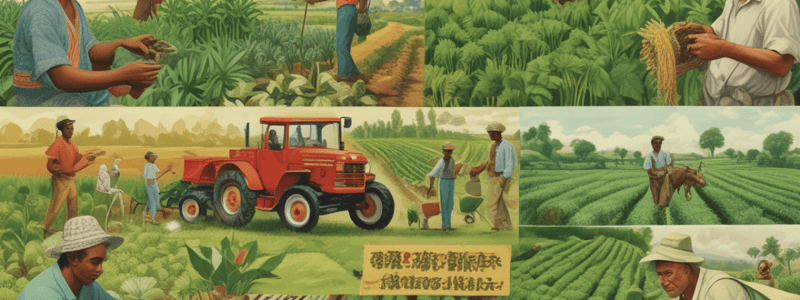Podcast
Questions and Answers
Which new farming methods were introduced during the Green Revolution?
Which new farming methods were introduced during the Green Revolution?
- Use of chemical fertilizers and pesticides (correct)
- Crop rotation and terracing techniques
- Organic farming and permaculture practices
- Aquaponics and hydroponics systems
What was one of the main focuses of the Green Revolution?
What was one of the main focuses of the Green Revolution?
- Conserving wildlife habitats
- Developing renewable energy sources
- Promoting industrialization
- Improving agricultural practices in developing countries (correct)
What was a significant development during the Green Revolution in terms of crop varieties?
What was a significant development during the Green Revolution in terms of crop varieties?
- Promotion of traditional crop varieties
- Introduction of genetically modified organisms
- Development of crops with reduced yields
- Introduction of high-yield varieties (HYVs) of wheat and rice (correct)
How did the high-yield varieties (HYVs) differ from traditional crop varieties?
How did the high-yield varieties (HYVs) differ from traditional crop varieties?
What positive impact did the Green Revolution have on crop yields?
What positive impact did the Green Revolution have on crop yields?
How did the Green Revolution contribute to reducing hunger and malnutrition?
How did the Green Revolution contribute to reducing hunger and malnutrition?
What enabled farmers to invest in better housing, education, and healthcare for their families during the Green Revolution?
What enabled farmers to invest in better housing, education, and healthcare for their families during the Green Revolution?
What was a key reason for developing new varieties of crops during the Green Revolution?
What was a key reason for developing new varieties of crops during the Green Revolution?
Why were high-yield varieties (HYVs) of wheat and rice introduced during the Green Revolution?
Why were high-yield varieties (HYVs) of wheat and rice introduced during the Green Revolution?
What was one outcome of the introduction of chemical fertilizers and pesticides during the Green Revolution?
What was one outcome of the introduction of chemical fertilizers and pesticides during the Green Revolution?
Flashcards are hidden until you start studying
Study Notes
The Green Revolution
- The Green Revolution was a period of time in the 1960s and 1970s when new farming methods were introduced to developing countries.
- The main goal was to increase food production and reduce hunger and poverty.
Countries Involved
- The Green Revolution was mainly focused on improving agricultural practices in countries such as India, Mexico, and the Philippines.
Key Innovations
- Scientists and researchers developed new varieties of crops that were more resistant to disease and pests, and could produce higher yields.
- They introduced the use of chemical fertilizers and pesticides to improve soil fertility and control crop damage.
High-Yield Varieties (HYVs)
- One of the most significant developments of the Green Revolution was the introduction of HYVs of wheat and rice.
- HYVs produced much larger harvests than traditional varieties, and farmers were able to grow more food on the same amount of land.
- HYVs were also shorter in height, which made them less likely to fall over during storms or heavy rains.
Impact of the Green Revolution
- Crop yields increased dramatically, and there was a surplus of food for the first time in these countries' histories.
- Hunger and malnutrition were reduced, and the overall health and well-being of the population improved.
- Farmers saw their incomes rise, and many were able to invest in better housing, education, and healthcare for their families.
Studying That Suits You
Use AI to generate personalized quizzes and flashcards to suit your learning preferences.




